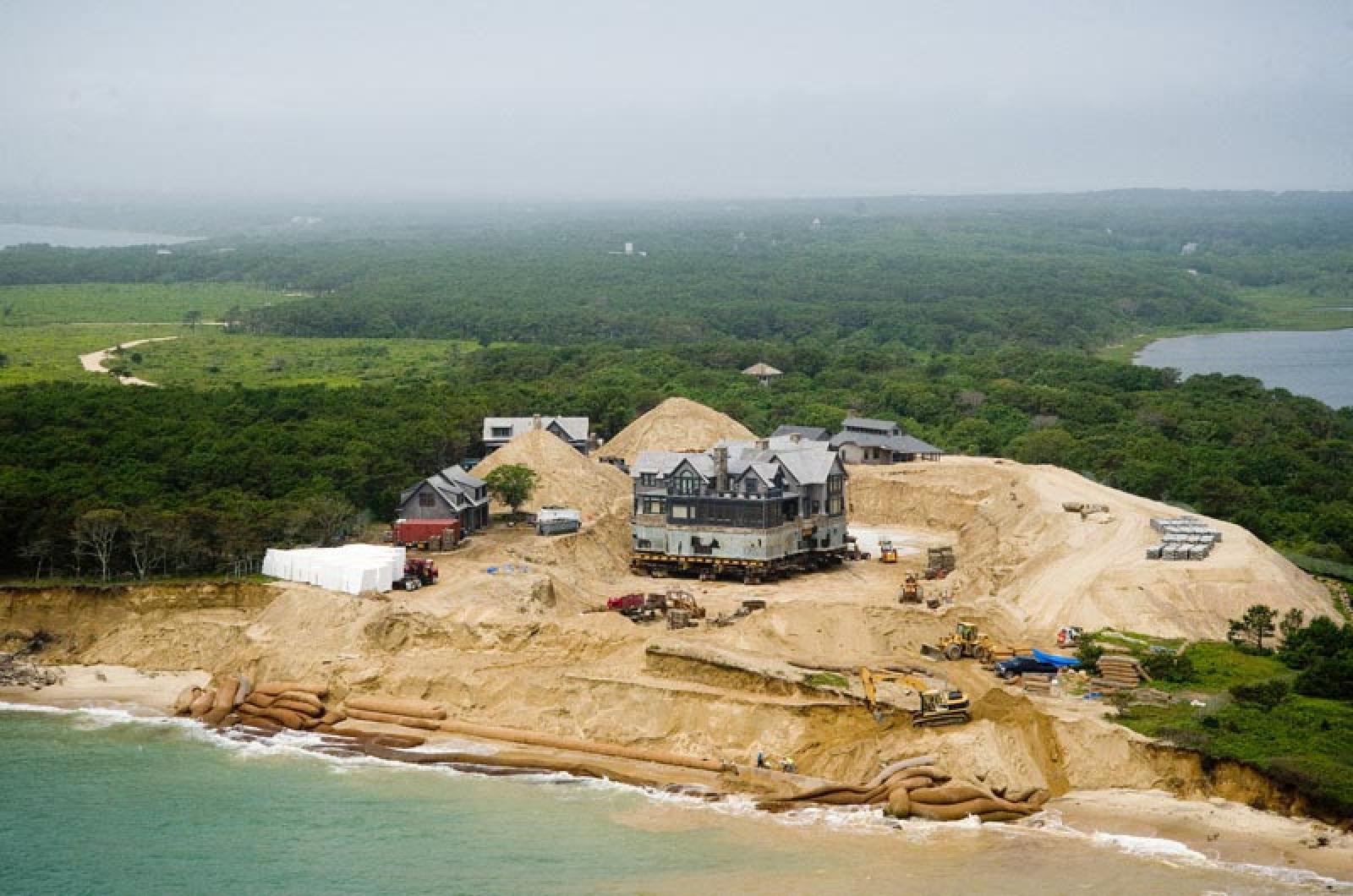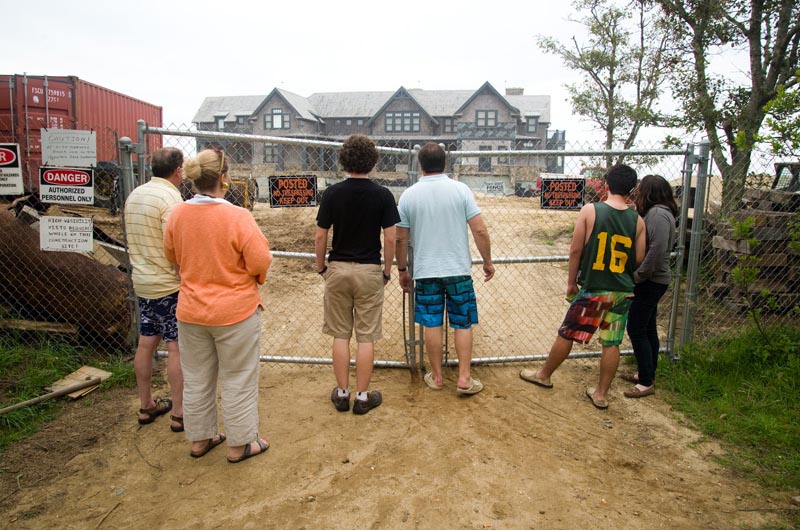After several days of inching forward along a deep, wide sandy trench, a Chappaquiddick home arrived late Tuesday at its new location farther away from a rapidly eroding bluff.
It’s been less than a year since emergency actions began to save the Wasque home of Richard and Jennifer Schifter. The key part of the project came this week with the move of the 8,300-square-foot main house, though the project is far from over.
Fog blew in over the ocean last weekend as the house, which was moved with a large basement attached, rested on about 20 small red dollies. The house had been excavated and was supported with steel beams, and it had to turned and positioned before it was moved, slowly but steadily, across the trench to new footings, said engineer George Sourati. Work began Friday and the house reached the final destination late Tuesday.
“We’re relieved that the house move itself went smoothly and without incident,” Mr. Schifter told the Gazette in an email Thursday. “We look forward to restoring the site to its natural beauty.”
The Schifters purchased nine acres of land on a remote promontory at Wasque in 2001. After a lengthy approval phase with the town of Edgartown, construction was completed on the property in 2007 by Chappaquiddick contractor Richard Knight Jr. and his partner Michael Zadeh. Besides the main house, the property had a guest house, garage and a swimming pool. At the time the house was built, it was 220 feet away from the coastal bluff.
But an April 2007 northeaster breached a barrier beach that once linked Wasque with Norton Point, causing complex changes to the currents.
By August 2012, the Schifters began to notice severe erosion at their property, and in September 2012, they turned to the town for emergency approval to protect the bank. A coastal geologist noted an erosion rate of .87 feet a day. By the beginning of 2013, plans emerged to move the house.
It is a complicated, multi-phase project. To have enough room to move the house, the Schifters purchased a neighboring property and house from the Leland family; that house was moved to make way for the big house. A complicated regulatory process unfolded in town hall, where town officials worked with coastal geologists, engineers and structure relocation specialists to hammer out the details of the project. Representatives from the Wampanoag Tribe of Gay Head (Aquinnah) were on hand in case artifacts were discovered; there was a brief delay when a refuse pit used by Native Americans centuries ago was discovered.
In late March, the project got the final approval and began in earnest: the guest house, then only 40 feet away from the bluff, was moved to a temporary location, and a swimming pool was dismantled. Topsoil, trees and shrubbery were removed and stored offsite. The main house was excavated and a trench dug between the house and its new location, which will be about 325 feet away from the bluff.
Piles of sandy subsoil surround the orderly worksite, which is enclosed with fencing dotted with numerous safety warnings. International Chimney Corporation, a New York-based company that specializes in structure relocation (it has moved the Sankaty Lighthouse and a Newark Airport terminal, among other things), is overseeing the move, and the work is being carried out by Expert House Movers Inc., a Maryland-based company.
The house move is far from the end of the project. Once the home is placed on its footings, Mr. Sourati said, a stone wall will be built between the footings and the house, and the steel beams will slowly be removed, which he said is a slow and tedious process.
The garage on the property still has to be moved, and a guest house that was temporarily relocated to make way for the house move will also have to be moved to its new spot. Excavated areas must be backfilled and compacted, utilities and the pool rebuilt, and landscaping restored.
The move happened about a week ahead of schedule.
So far, Chappaquiddickers say the project hasn’t had much of an impact on the small community, outside of a bit of what could be called Schifter house fatigue.
“The thing is, I think everyone’s sort of sick of it,” said Chappaquiddick Island Association president Roger Becker.
Chris Kennedy, the Vineyard superintendent for The Trustees of Reservations, said there has been little impact at Wasque Reservation, which abuts the Schifter property. “They’ve been very, very good about maintaining roads . . . I’m very happy,” Mr. Kennedy said.
One of his concerns was that the house would be visible at its new location from Trustees property. But “what I’m kind of tickled about, is just this afternoon I drove down out to fisherman’s parking lot . . . no sign of the [house]. It’s really gratifying to see,” he said.
Carol Kennedy, Mr. Kennedy’s wife, said she has only noticed a small change in the sounds outside their Wasque home. Going outside in the daytime, she said, “you normally don’t hear anything except birds and surf.”
Now, she said, “you hear the beep-beep of machines.”
The Schifters themselves were praised for being good and generous neighbors who invite Chappaquiddickers to an annual holiday party.
“I like them a lot,” Mrs. Kennedy said, noting that in meetings about the house move they were willing to listen. “Rick and his wife, they just seem to be very down to earth . . . the Schifters have always been very nice.”
Peter Wells, owner of the Chappaquiddick Ferry, agreed. “There was not really any noticeable impact,” he said. “It’s worked out well.”
Most of the main truck trips were completed three weeks ago, and original fear of heavy truck traffic up and down Chappaquiddick’s rural roads did not prove to be true, Mr. Wells said.
If anyone is tuned into conversation on Chappaquiddick it’s Mr. Wells, whose small three-car ferry takes residents and visitors back and forth daily on its short route. “It’s a big topic of discussion,” he said of the house moving project. “A lot of the Chappy people have gotten to know the guys doing the work.”
Often, people would surround workers in their vehicles, asking them questions, he said. The big one was: “Are you on schedule?”
And the workers were welcomed to the community. “We got them to come to a couple of the potlucks,” Mr. Wells said, referring to the monthly potluck suppers held at the Chappaquiddick Community Center.
At one of the town meetings about the house move, Mr. Wells recalled, he was put on the spot to share his opinion. “He’s a nice guy, we gotta help him out,” he recalled saying.
“That’s exactly what I felt. He is a nice guy, we gotta help him out. Why leave a guy hanging out there?”
The house move was not the only project underway this week at the Schifter property.
A system of stacked coconut fiber logs built to slow the erosion on the bluff is also being reconstructed. The logs, called coir envelopes, are stacked against the bluff and must be repaired because several had collapsed, Mr. Sourati said. The bluff has had an additional 10 feet of erosion recently.
The coir envelopes will remain in place at least until the excavated areas have been filled in and compacted.
Mr. Becker said like others, he is focused on what comes next.
“I’ll be interested in seeing how quick the beach is scoured after he removes his coir logs,” he said. “I think that’ll be the telling thing, whether that’s a good investment or not. It’s pretty amazing how quickly the ocean’s reclaiming things.”









Comments (10)
Comments
Comment policy »